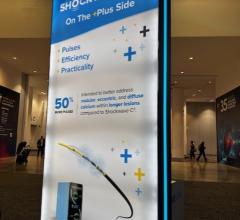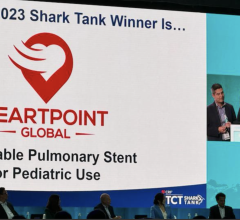
October 20, 2015 — A pair of studies presented at the 27th annual Transcatheter Cardiovascular Therapeutics (TCT) scientific symposium showed no late benefit of thrombus aspiration during percutaneous coronary intervention (PCI) in patients with ST-segment elevation myocardial infarction (STEMI).
The TOTAL study was a prospective, randomized, investigator-initiated trial of routine manual thrombectomy with PCI versus PCI alone in patients with STEMI within 12 hours of symptom onset. The study enrolled 10,732 eligible patients from 87 hospitals in 20 countries. Using a 1:1 randomization, patients were assigned to thrombectomy followed by PCI (n=5,372) or to PCI alone (n=5,360). After excluding patients who did not undergo PCI in each group (337 in the PCI and thrombectomy group and 331 in the PCI alone group), the final study population was comprised of 10,064 patients (5,035 thrombectomy and 5,029 PCI alone).
The primary outcome (a composite of cardiovascular death, recurrent myocardial infarction, cardiogenic shock or class IV heart failure) at one year occurred in 395 (8 percent) of 5,035 patients in the thrombectomy group compared with 394 (8 percent) of 5,029 in the PCI alone group (hazard ratio [HR] 1.00 [95 percent CI 0.87–1.15], p=0.99). Cardiovascular death at one year occurred in 179 (4 percent) of the thrombectomy group and in 192 (4 percent) in the PCI alone group (HR 0.93 [95 percent CI 0.76–1.14], p=0.48). Recurrent myocardial infarction, cardiogenic shock or heart failure at one year were similar between the groups, as were all-cause death, stent thrombosis, definite stent thrombosis, target vessel revascularization and major bleeding.
The key safety outcome of the study, stroke within one year, occurred in 60 patients (1.2 percent) in the thrombectomy group compared with 36 (0.7 percent) in the PCI alone group (HR 1.66 [95 percent CI 1.10–2.51], p=0.015).
“Routine thrombus aspiration during PCI for STEMI did not reduce cardiovascular death, myocardial infarction, shock or heart failure after one year compared with PCI alone,” said lead investigator Sanjit S. Jolly, M.D., MSc. Jolly is an interventional cardiologist at Hamilton Health Sciences and an associate professor at McMaster University in Hamilton, Canada.
“A strategy of routine thrombus aspiration may be associated with an increased rate of stroke. The TOTAL trial is the largest trial of thrombus aspiration with significantly more power to detect differences in which stroke was a prespecified safety outcome. As a result, thrombus aspiration can no longer be recommended as a routine strategy in STEMI.”
The second trial was designed as a prospective, randomized, controlled, single-blind, single-center study. Patients with subacute STEMI presenting between 12 and 48 hours after symptom onset were randomized in a 1:1 ratio to manual thrombus aspiration (n=70) or standard PCI alone (n=74). The primary endpoint was the extent of microvascular obstruction (MVO) assessed by cardiac magnetic resonance imaging (CMR) one to four days after randomization. Secondary endpoints included measures of CMR (infarct size, myocardial salvage, left ventricular ejection fraction and volumes), angiography (TIMI flow post-PCI and myocardial blush grade post-PCI), enzymatic infarct size (high-sensitivity troponin T after 24 and 48 hours) and clinical outcomes after 30 days.
The extent of MVO was not significantly different between patients assigned to thrombus aspiration and PCI alone (2.5 ± 4 percent vs.3.1 ± 4.4 percent, p=.47, respectively). There were also no significant differences in infarct size, left ventricular ejection fraction, or angiographic and clinical endpoints between groups.
“In patients with subacute STEMI, routine manual thrombus aspiration before PCI failed to show a significant reduction in the primary endpoint of microvascular obstruction assessed by cardiac magnetic imaging compared to conventional PCI alone,” said lead investigator Steffen Desch, M.D. Desch is a professor at the University of Schleswig-Holstein, Campus Lübeck in Lübeck, Germany.
“This finding is further supported by a lack of benefit in angiographic, enzymatic, and clinical secondary endpoints.”
For more information: www.tctconference.com


 May 05, 2025
May 05, 2025 








